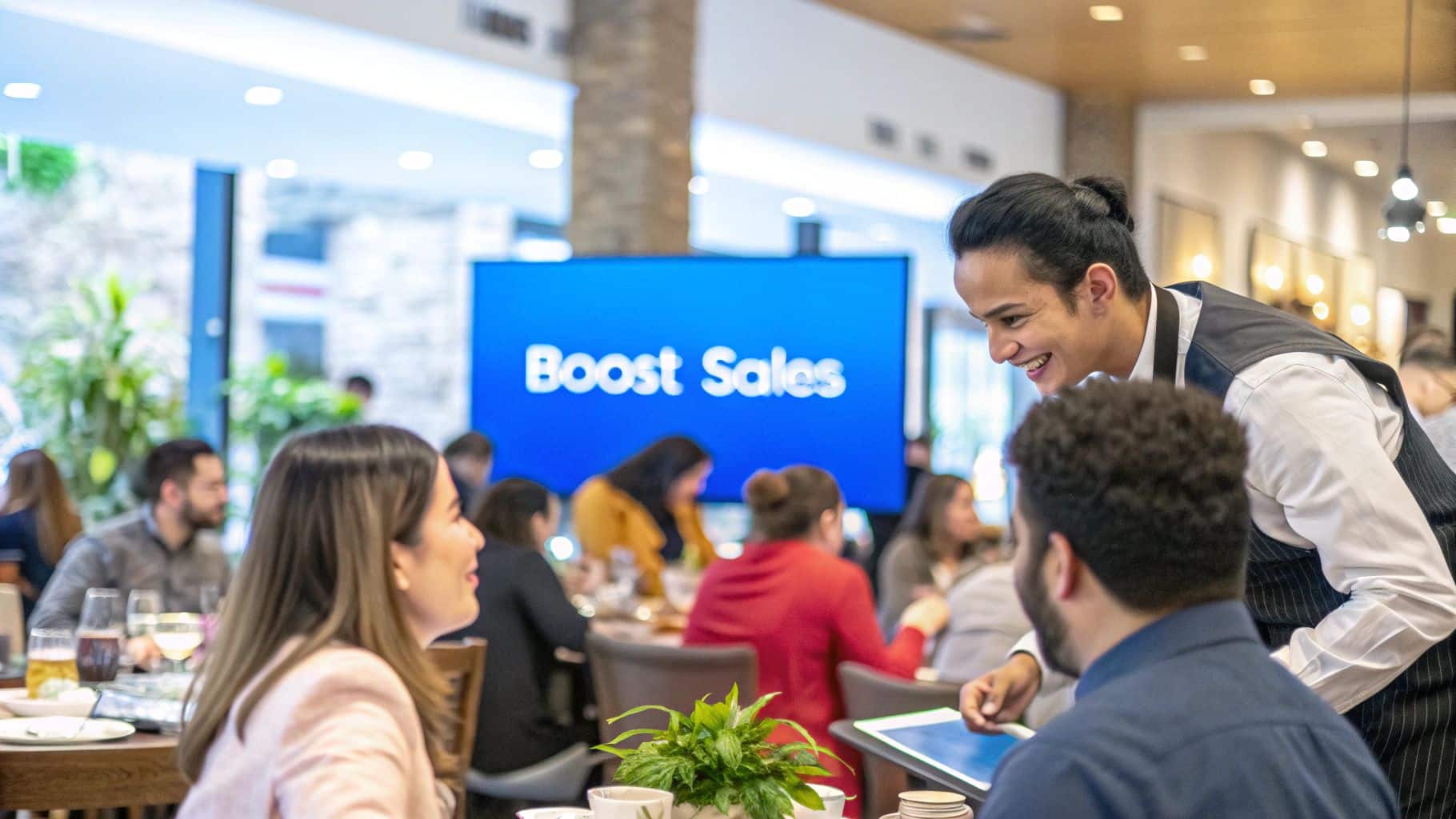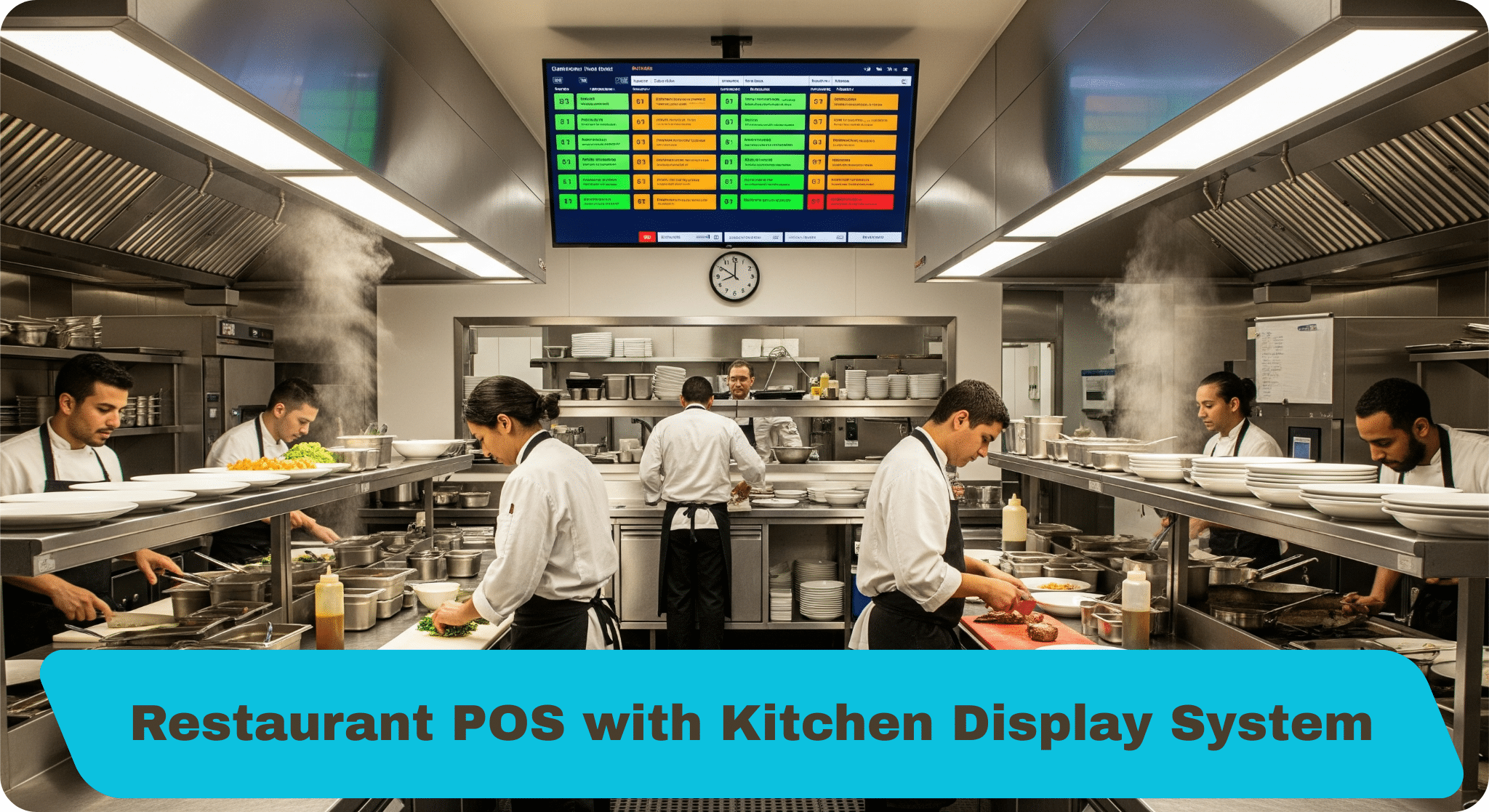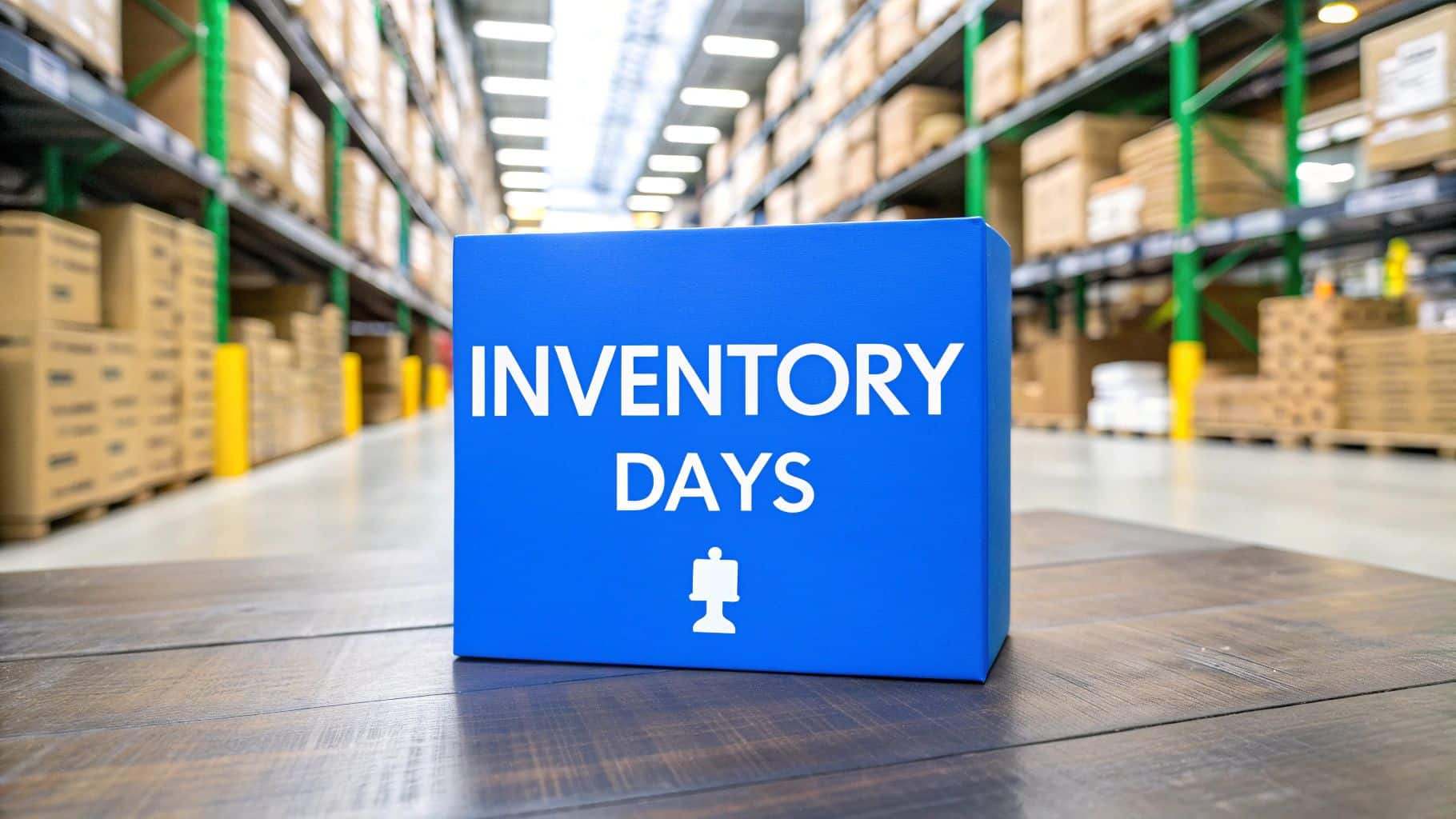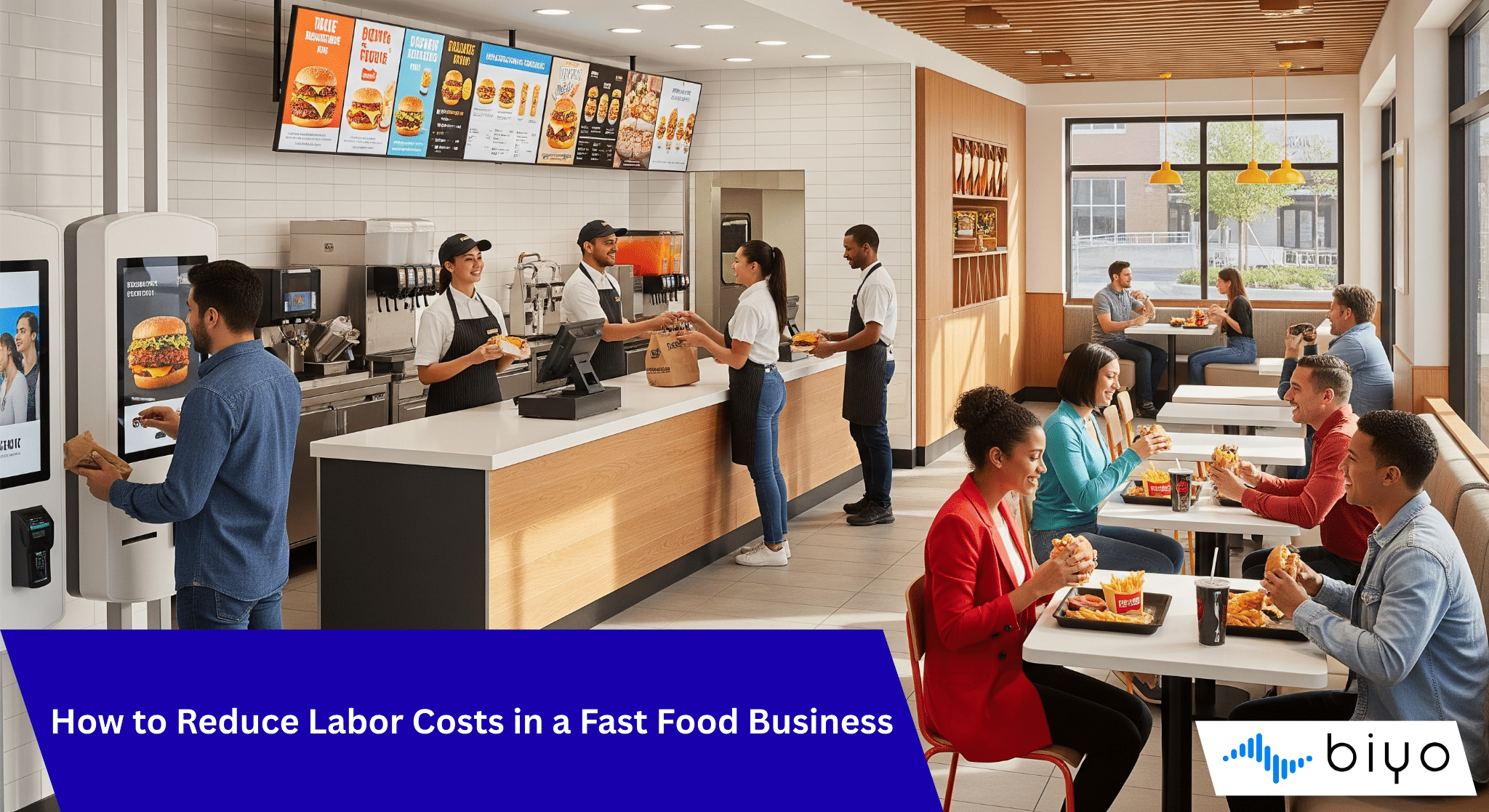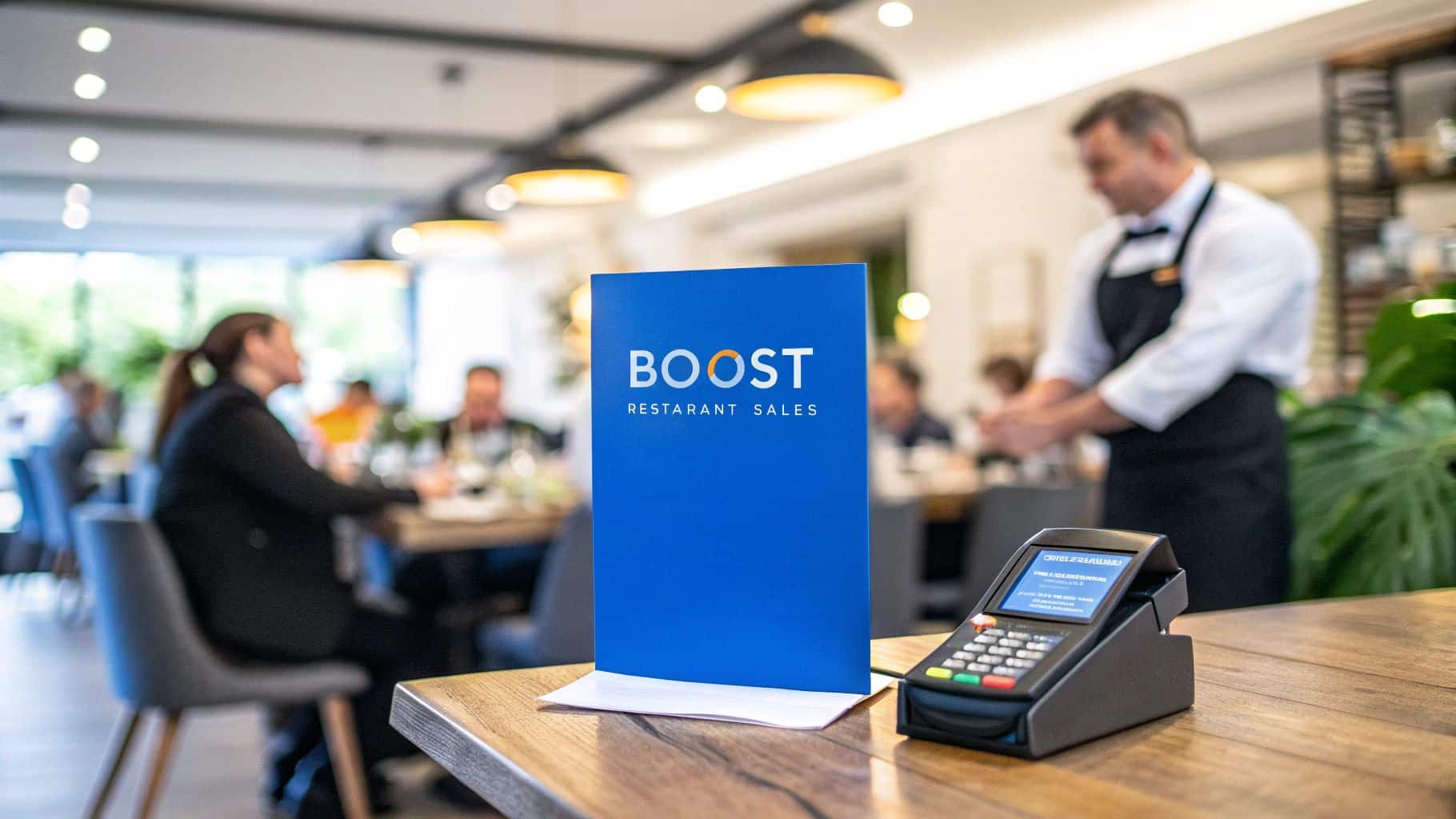Boosting restaurant sales isn't about finding one magic bullet. It’s a combination of smart, interconnected strategies. The most successful restaurants I've seen master a few key areas: they optimize their menu for maximum profit, use savvy digital marketing to get new faces in the door, create an in-house experience people rave about, and build a loyal following that keeps coming back for more.
Your Starting Point For Boosting Restaurant Sales
Thriving in today's restaurant scene takes more than just amazing food. It requires a clear, actionable plan for growth. This guide isn't about high-level theories; it’s a practical playbook filled with data-driven moves that will directly fatten up your bottom line.
Think of this as your roadmap to sustainable success. We're going to dive into the core pillars that smart restaurant owners obsess over day in and day out.
The Four Pillars of Restaurant Growth
To really get a handle on how to improve your sales, you need to look at your business through four distinct, yet connected, lenses. Each one is absolutely vital to your financial health and staying power.
- Menu Profitability: Your menu is your number one sales tool. It’s not just a list of what you serve; it's a strategic document that should be engineered to squeeze the most profit from every single order.
- Digital Presence: Right now, someone in your neighborhood is online looking for a place to eat. A strong digital footprint—from Google search to Instagram—is how you make sure they find you before your competition.
- In-House Experience: The vibe, the service, the little details—this is what turns a meal into an experience. A fantastic experience is the engine that drives great reviews and priceless word-of-mouth marketing.
- Customer Loyalty: Getting a new customer is great, but keeping one is where the real money is. A solid base of regulars provides a reliable, predictable stream of revenue you can count on.
Success isn't about being perfect in just one of these areas. It’s about how they all work in harmony. A brilliant marketing campaign that brings in a flood of new customers will fall flat if the in-house experience and menu don't live up to the hype.
Before you jump in, you have to know which numbers truly matter. For the bigger picture, understanding a full range of business growth marketing strategies is also a game-changer.
Master Your Menu For Maximum Profitability
Think of your menu as more than just a list of what you sell—it's your most powerful sales tool. A static, unchanging menu is a huge missed opportunity. If you really want to improve restaurant sales, you have to treat your menu like a finely tuned machine, engineered to drive profit with every single order.
This process is called menu engineering, and it’s a perfect blend of art and science. It’s all about digging into the data for each item, looking at its popularity (how often it sells) against its profitability (the margin you make). This analysis is what empowers you to make smart, strategic decisions that guide your customers toward your most lucrative dishes.
Categorizing Your Menu Items
First things first, you need to sort every dish into one of four groups. This simple framework brings a ton of clarity, showing you exactly what’s working and what’s dragging your profits down.
- Stars: These are your rockstars—high in both popularity and profitability. Customers love them, and they make you great money. Your job is to feature them prominently and never, ever let the quality slip.
- Plowhorses: Everyone loves these dishes, but their profit margins are on the lower side. They fly out of the kitchen, but they don't contribute to the bottom line as much as your Stars do. The goal here is to find ways to gently nudge up their profitability without scaring away customers.
- Puzzles: These are your high-profit but low-popularity items. You make a great margin when they sell, but they just aren't ordered often enough. Your mission is to figure out why and find clever ways to get more people to give them a try.
- Dogs: These are the underperformers, plain and simple. Low in popularity and low in profitability. They’re taking up precious real estate on your menu and often cost you more in prep and inventory than they're worth. These are the prime candidates for a complete reinvention or, more likely, removal.
If you want to go deeper into this quadrant analysis, our complete guide on menu engineering as a strategic approach to maximizing profitability is a great resource. It walks you through the entire process, step by step.
Applying Menu Psychology And Design
Once you’ve got your items categorized, it's time for the fun part: redesigning your menu to subtly influence what your guests order. The layout, the descriptions, even the font can have a massive impact. I've seen simple design tweaks increase sales of a single item by up to 30%.
Place your "Stars" where they can't be missed. Studies show that a guest's eyes are naturally drawn to the top-right corner of a menu, making it prime real estate for your most profitable dishes. Use simple visual cues like a box, an icon, or slightly bolder text to make these items pop.
Don't just list ingredients; tell a story. Using descriptive, mouth-watering language can make a dish irresistible. Instead of "Chicken Breast," try something like "Pan-Seared, Free-Range Chicken Breast with a Rosemary-Garlic Reduction." It paints a picture and builds anticipation before the plate even hits the table.
Pricing Strategies That Work
Pricing isn't just about covering costs; it's also a powerful psychological tool. A common trick is charm pricing—ending prices in .99 or .95. While that works well in retail, many restaurants find that dropping the dollar sign and cents (listing a price as "18" instead of "$18.00") makes the cost feel less significant and keeps the focus on the food.
That said, you have to stay connected to what your customers are feeling. According to Yelp data, as the cost of living went up, searches for “meal deal” shot up by 117% and “value meal” searches climbed 22% year-over-year. This is a clear signal that people are looking for affordability.
Interestingly, at the same time, searches for "sweet treat" jumped 110%. This tells us that while people are budget-conscious, they’re still looking for small, affordable indulgences. The takeaway? A balanced approach is key. Offer clear value, but don't forget to promote those profitable add-ons like desserts and specialty cocktails.
Actionable Strategies For Each Category
Let's tie this all together with some practical moves you can make for each category to boost your overall profitability.
- Promote Your Stars: If it ain't broke, don't fix it. Never mess with a Star's recipe or price unless you absolutely have to. Instead, make them impossible to ignore on the menu and train your servers to recommend them with genuine excitement.
- Adjust Your Plowhorses: With these popular but lower-margin items, try a small, incremental price increase. Another tactic is to slightly reduce their food cost by tweaking portion sizes or sourcing a more cost-effective ingredient, as long as it doesn't compromise quality.
- Rework Your Puzzles: These high-profit items just need a little marketing push. Give one a more exciting name, feature it as a weekly special, or write a more tantalizing description. A fantastic photo on your social media or online menu can often be all it takes to pique someone's curiosity.
- Re-evaluate Your Dogs: It's time to be ruthless. For these low-profit, low-popularity items, the best move is usually to cut them loose. Removing them from the menu simplifies your kitchen operations, reduces food waste, and lets you focus on the dishes that truly matter.
Use Smart Pricing and Promotions to Your Advantage
Finding that sweet spot between packing the house and protecting your profit margins is one of the oldest challenges in the restaurant game. The secret isn’t just slashing prices—it’s about using smart pricing and well-timed promotions as strategic tools to grow your business, drive sales, and build a base of regulars.
When you think beyond simple price cuts, you can drive traffic during those dreaded slow periods, make your food seem even more valuable, and gently nudge the average check size upwards. This is about playing offense, not defense.
Think Beyond the Basic Discount
A simple 10% off might grab a little attention, but creative promotions almost always deliver better results without making your brand look cheap. The real goal is to design offers that feel like a special event and encourage customers to do what you want them to do, like stopping by on a quiet Tuesday night or trying a new high-margin dish.
Every great promotion starts with a clear purpose. Here are a few tactics I’ve seen work wonders:
- Rethink Your Happy Hour: Don't just knock a dollar off drinks. Build a killer happy hour menu with attractively priced, high-margin small plates. This strategy brings people in during that late-afternoon slump and often convinces them to stick around for a full dinner.
- Create Prix-Fixe Menus: Offering a multi-course meal (think appetizer, main, and dessert) for one set price feels like a fantastic deal to guests. It also simplifies their decision-making and gives you total control over food costs, locking in a profit on every order.
- Craft Compelling Bundles: Get creative with a "Date Night Special" or a "Family Feast." Bundling items together is a proven way to get customers to spend more than they would have ordering everything separately. It’s a brilliant move for boosting your average check size.
Build Loyalty That Actually Sticks
A truly great loyalty program is about more than just transactional rewards. It’s about building a genuine connection that keeps people coming back. Instead of a basic "buy 10, get one free" punch card, think about a points-based system where customers earn rewards for every dollar they spend. It feels more flexible and makes every single purchase feel like progress.
The best loyalty programs make customers feel like they're part of an exclusive club. Offer them first dibs on new menu items, invite them to members-only events, or send a special treat on their birthday. These personal touches create an emotional bond that a simple discount could never replicate.
Understanding your menu's profitability helps you decide which items to feature. As this chart shows, different categories contribute differently to your bottom line.
Knowing that main courses often have the highest profit margins, you can strategically build your bundles and prix-fixe menus around them to really maximize your revenue.
How to Handle Price Increases in Today's Market
With costs for everything on the rise, balancing promotions with the need to stay profitable is trickier than ever. The entire industry is feeling this squeeze. One 2025 industry report from Square found that while a staggering 98% of restaurant leaders were expanding discount offers, 73% also had to plan price increases just to manage their operational costs. The most successful operators have figured out how to use promotions to drive traffic while carefully adjusting prices to protect their margins.
When you do have to raise prices, communication is everything. Be upfront with your regulars. A simple, honest note on your menu or a post on social media explaining the change—whether it’s to maintain quality or pay your team a fair wage—goes a long way. Nobody likes a surprise on their bill.
Promotions are just one piece of the puzzle. Nailing your core pricing is fundamental to your restaurant's financial health. To help you get it right, we put together a comprehensive guide to restaurant menu pricing strategy that shows you how to maximize profits with ease. It’s a must-read for building a profitable foundation for any promotion you decide to run.
Below is a quick comparison of popular promotional strategies to help you choose the right tool for the job.
Effective Restaurant Promotion Strategies
| Promotion Type | Primary Goal | Best For | Potential Pitfall |
|---|---|---|---|
| Happy Hour | Drive traffic during off-peak hours | Restaurants with a strong bar program and slow afternoon periods | Attracting deal-seekers who don't stay for a full-priced meal |
| Bundle Deals | Increase average check size | Family-style restaurants, QSRs, or concepts with complementary items | Can be complex to execute and may not appeal to solo diners |
| Prix-Fixe Menu | Create perceived value; control food costs | Fine-dining, special occasions, or restaurants wanting to showcase specific dishes | Less flexibility for customers with dietary restrictions or preferences |
| Loyalty Program | Encourage repeat business and build community | All restaurant types, especially neighborhood spots with regular customers | If too complicated or unrewarding, customers will simply ignore it |
Choosing the right promotion depends entirely on what you're trying to achieve—whether it's filling seats on a Wednesday or getting customers to spend a little more per visit.
Expand Your Reach With Digital Marketing
These days, your online presence is just as critical as your physical location. For many potential customers, their first encounter with your restaurant won't be walking through the door. It’ll be finding you on Google Maps, stumbling across your food on Instagram, or checking out your reviews on Yelp.
If you’re serious about boosting sales, you have to win on the digital front. This goes way beyond just having a basic website. It’s about creating an active, engaging online footprint that constantly draws in new people and keeps your regulars excited to come back.
Dominate Local Search Results
When a hungry person in your neighborhood pulls out their phone and types "food near me," you need to show up. That’s the entire game of local search engine optimization (SEO). It’s all about making your restaurant as visible as possible on platforms like Google.
Your single most important tool for this is your Google Business Profile. Treat it like your digital storefront. It has to be complete, accurate, and appealing. We're talking high-quality photos, up-to-the-minute hours, your full menu, and a direct link for reservations.
Gently encouraging happy customers to leave reviews is a huge piece of this puzzle. Those positive ratings are gold and directly impact how high you rank in local search results.
Manage Your Online Reputation
Think of your online reviews as modern word-of-mouth. A steady stream of great reviews can easily convince a hesitant newcomer to give you a shot. On the flip side, a few bad ones can send them running to your competition. This is why you have to be on top of your reputation management.
Get into the habit of monitoring reviews everywhere, not just on Google. When a good one comes in, a quick "thank you" goes a long way. More importantly, when you get a negative review, respond quickly and professionally.
Addressing a negative review publicly shows everyone that you take customer feedback seriously. Offer to make things right offline. This simple act can often turn a disgruntled customer into a loyal one and demonstrates your commitment to excellent service to everyone else watching.
Handling feedback the right way builds trust and protects your brand, which is fundamental for long-term growth.
Harness The Power Of Social Media
Social media, particularly visual-heavy platforms like Instagram and TikTok, is where you can let your restaurant’s personality shine. It’s less about hard-selling and more about telling your story and building a community. In fact, studies show that 49% of diners now use social media to find and book restaurants.
Here's how to make it work for you:
- Post drool-worthy photos and videos of your best dishes, your staff having fun, and the vibe of your dining room.
- Share some behind-the-scenes magic, like a chef testing a new recipe or your team getting ready for a big service.
- Talk to your followers! Respond to their comments, run fun polls, and share their posts when they tag you (always ask for permission first).
- Use local hashtags and tag your location so people in your area can discover your posts.
For a deeper dive into building an effective online strategy, check out these top digital marketing tips for small businesses.
Navigate Online Ordering And Delivery
Third-party delivery apps are great for getting your name in front of a huge new audience. The catch? Those commission fees can take a serious bite out of your profits. The trick is to use them as a tool to find new customers, while always pushing people to order from you directly.
You need to make ordering directly from your restaurant the best possible option. Maybe that means offering a small discount or an exclusive item only available on your website or for phone-in orders. A great tactic is to slip a small flyer into every third-party delivery bag, promoting the benefits of ordering direct next time.
The shift to digital is undeniable. The global foodservice market hit roughly $3.09 trillion in 2024-2025 and is on track to blow past $4.1 trillion by 2033. A huge part of that growth is technology, with digital ordering alone projected to be a $380 billion market in 2025. The numbers don't lie—investing in your digital presence isn't just a good idea; it's essential for your restaurant's survival and growth.
Make the Customer Experience Unforgettable
A fantastic menu might get people in the door, but it’s an outstanding experience that turns them into regulars who can’t stop talking about you. The food can be flawless, but if the service feels cold or the atmosphere is off, that’s what your guests will remember.
The real key to unlocking repeat business—and the powerful word-of-mouth marketing that comes with it—is a deep focus on genuine hospitality. It’s about moving past just service, which is the technical part of taking an order and delivering a plate. Hospitality is all about how you make people feel. It’s that warmth and personal connection that shows you genuinely care about their time with you.
Train for Hospitality, Not Just Service
Your front-of-house team is the heart and soul of your restaurant. Seriously, investing in their training is one of the most effective ways you can improve restaurant sales for the long haul. While anyone can be taught the steps of service, true hospitality has to be nurtured.
Empower your team to go beyond the script. Instead of just rolling through the motions with a generic "How is everything?", train them to actually observe and connect. For example, if a server notices a guest has barely touched their meal, they should feel confident enough to ask, "I see you haven't touched your risotto. Is there anything wrong? I'd be happy to bring you something else."
That simple, proactive step shows a level of care that turns a meal into a memory. It also works for upselling. If your team learns a table is celebrating an anniversary, they can suggest a special bottle of wine that pairs perfectly with their food, elevating the moment and naturally boosting the check size.
Curate an Atmosphere They Won't Forget
The customer's experience starts the second they walk through the door, way before the first bite of food. Every little detail of your restaurant's ambiance adds to how they feel about your brand. Think of it like a stage—every element should tell the story you want to tell.
Here are a few small things I’ve seen make a huge difference:
- The Soundtrack: Are you just playing generic pop radio, or is it a playlist you’ve actually curated to match your restaurant’s vibe? The right music sets the entire mood.
- The Lighting: Nobody likes harsh, overhead lights that feel like a cafeteria. Warm, layered lighting creates intimacy and makes guests feel relaxed. When they relax, they tend to linger, which often means another round of drinks or dessert.
- The Cleanliness: This goes way beyond just wiping down tables. Guests notice the little things—clean windows, dust-free light fixtures, and especially spotless restrooms. A pristine bathroom is a sign of a well-run, professional kitchen and restaurant.
Actively Seek Out (and Act on) Feedback
You can't fix what you don't know is broken. Giving customers easy ways to share their feedback is non-negotiable for getting better. And while online review sites are one place to look, they often only capture the really good or the really bad experiences.
The most valuable insights I've ever gotten came directly from guests while they were still in the building. Get your managers on the floor, walking around and chatting with tables. A simple, open-ended question like, "What was the highlight of your visit tonight?" can uncover so much.
For something a bit more structured, you could put a QR code on your receipts linking to a quick survey. To sweeten the deal, offer a small incentive, like 10% off their next visit.
But the most important part is what you do with that information. If you hear from a few people that the corner booth is drafty, get it fixed. When you act on feedback, you show customers you’re listening and that you're committed to giving them the best experience possible. That’s how you build a loyal following.
Got Questions About Boosting Restaurant Sales? We've Got Answers.
Even the most seasoned restaurant owners run into roadblocks. When you're in the trenches trying to figure out how to drive sales, some common questions always seem to surface. Let's tackle them head-on with some practical advice you can put to work today.
What’s The Fastest Way to See a Jump in Sales?
If you need a quick win, a well-planned limited-time offer (LTO) is your best bet. Don't just discount anything; pick a high-profit item and build an irresistible bundle around it. Think entree, drink, and dessert for one compelling price. The goal here isn't just to sell more, but to bump up that average check size.
Get the word out everywhere—plaster it on your social media and put up signs in your restaurant. Another immediate impact move? Upselling. Train your team to naturally suggest simple, profitable add-ons. "Would you like to add our truffle fries?" or "Have you tried our new craft cocktail with that?" These small suggestions really compound over a busy dinner service.
How Much Should I Actually Spend on Marketing?
You'll often hear the benchmark of 3-6% of your total revenue, but honestly, how you spend that money matters way more than the specific number. If you're starting out or on a tight budget, focus on the high-impact, low-cost stuff first.
Get these fundamentals right before you spend a dime on ads:
- Make your Google Business Profile your best friend. It needs to be perfect for local search.
- Actually talk to people on your social media accounts. Consistent engagement goes a long way.
- Start building an email list. It's your direct line to your most loyal customers for promotions.
Once these channels are humming and you're seeing a return, then you can intelligently reinvest some of that profit into paid ads on social media or Google. That's when you can target locals who are literally searching for a place to eat right now.
My Food Is Amazing, but We're Still Slow. What Gives?
Great food with low foot traffic almost always points to one thing: an awareness problem. People can't eat your food if they don't know you exist. You need to make local digital marketing your absolute obsession.
First things first, get your online listings in order. Make sure your restaurant profile on Google Maps, Yelp, and other directories is flawless. We're talking mouth-watering photos, up-to-the-minute hours, and a steady flow of fresh, positive reviews.
Once that's solid, start running geo-targeted ads on social media. Aim them at people within a 5-10 mile radius of your front door. You can also create a reason for people to come in now. Host a trivia night, book some live music, or partner with a local brewery for a tap takeover. Events create urgency and give people a reason to choose you tonight instead of "sometime."
